.
21.06.2015

FULL HALO CME: Sunspot AR2371 erupted on June 21st at 01:42 UT, producing an M2-class solar flare and a full-halo CME. Click to view a movie of the storm cloud, which is heading directly for Earth:
.
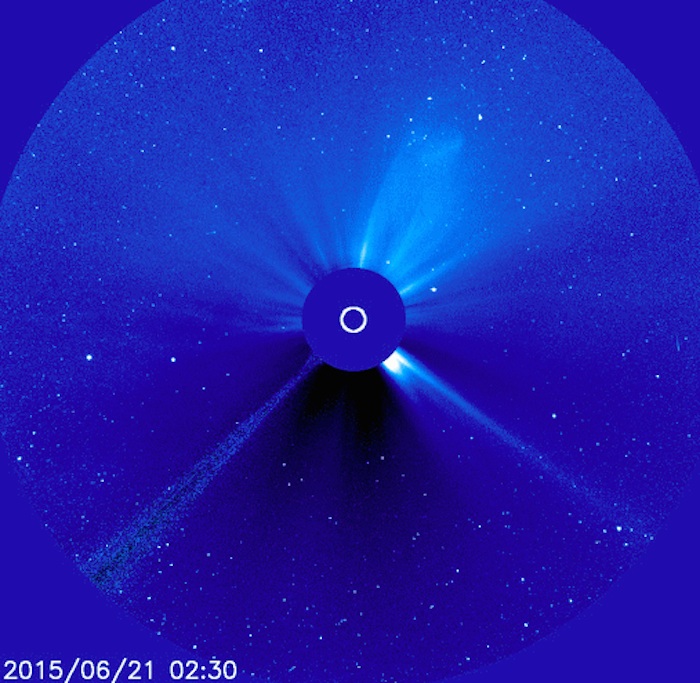
Geomagnetic storms are likely when the CME reaches Earth, probably on June 23rd or 24th. Its impact will add to that of two lesser CMEs already en route. NOAA analysts are modeling the full-halo CME now and, shortly, they will give their estimates for its arrival time and the severity of the resulting storm. Stay tuned for updates.
Quelle: Spaceweather
---
Update: 23.06.2015
.
Sun Unleashes Mid-level Flare
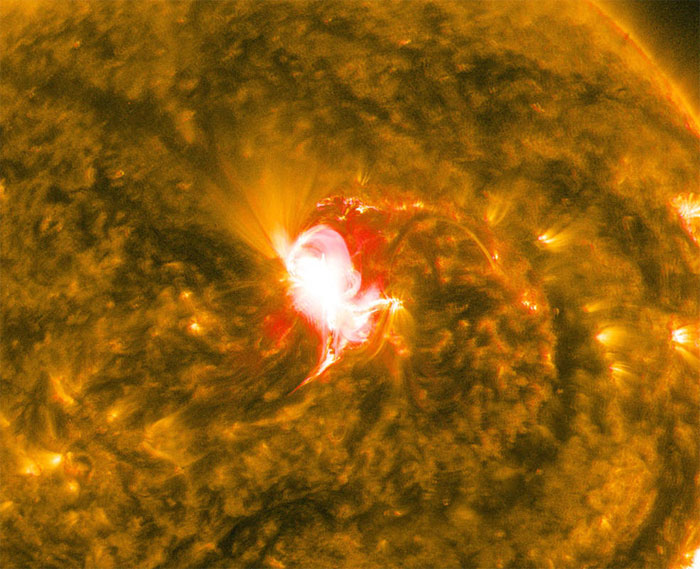
SDO captured this image of the mid-level flare, an M6.6-class, on June 22, 2015.
Credits: NASA/SDO
.
The sun emitted a mid-level solar flare, peaking at 2:23 p.m. EDT on June 22, 2015. NASA’s Solar Dynamics Observatory, which watches the sun constantly, captured an image of the event. Solar flares are powerful bursts of radiation. Harmful radiation from a flare cannot pass through Earth's atmosphere to physically affect humans on the ground, however -- when intense enough -- they can disturb the atmosphere in the layer where GPS and communications signals travel.
To see how this event may affect Earth, please visit NOAA's Space Weather Prediction Center at http://spaceweather.gov, the U.S. government's official source for space weather forecasts, alerts, watches and warnings.
This flare is classified as a M6.6 flare. M-class flares are a tenth the size of the most intense flares, the X-class flares. The number provides more information about its strength. An M2 is twice as intense as an M1, an M3 is three times as intense, etc.
Updates will be provided as needed.
Quelle: NASA
.
Update: 23.06.2015
-
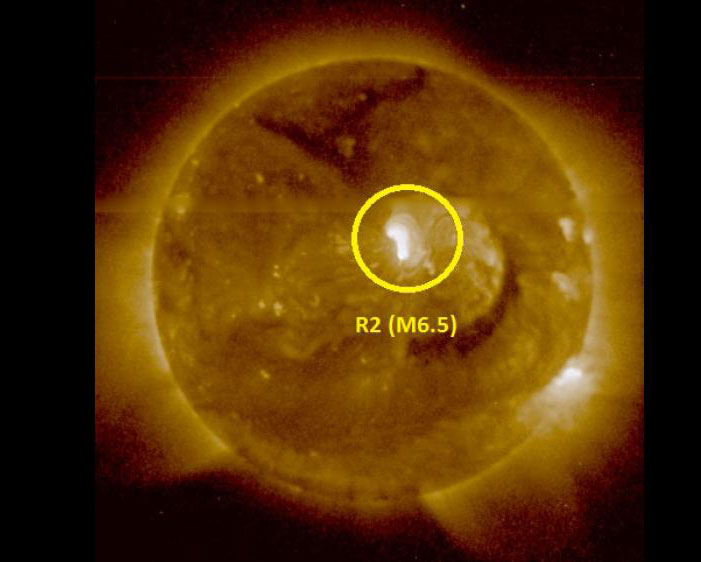
ONE EVENT ARRIVES, ANOTHER ONE COMING?
published: Monday, June 22, 2015 20:33 UTC
At 1823 UT (12:23 PM EDT), the active region that produced the event hitting Earth right now erupted again. A long duration x-ray flare reached R2 (Moderate) Radio Blackout levels, as seen in the accompanying GOES Solar X-Ray Imager picture. Thus, users impacted by solar flares and users impacted by geomagnetic storms were each being affected. Just as importantly, early imagery indicates a coronal mass ejection (CME) also erupted. More data are needed to confirm the direction and speed of the CME, so stay tuned here for more updates. In the meantime, the Solar Radiation storm continues unabated, briefly reaching S3 levels, so June 22 has seen significant space weather across all of the NOAA Space Weather Scales.
.

G4 ALERT: ANOTHER STORM REACHES SEVERE LEVELS
published: Monday, June 22, 2015 20:33 UTC
The geomagnetic storm began as forecasted and quickly ramped up to severe (G4) levels. SWPC issued the G4 Alert at 1858 UT (2:58 pm EDT), after the storm slammed into Earth at 1839 UT (2:39 pm EDT). This is the same intensity level reached in March, 2015 during the St. Patrick's Day storm. This is the very early stages of an event that will play out over many hours, with SWPC forecasting continuing storm level intensities into tomorrow. In Europe watchers should be looking for the aurora now and there is hope for those over the US tonight. Stay tuned here, as there is more happening to tell you about.
.
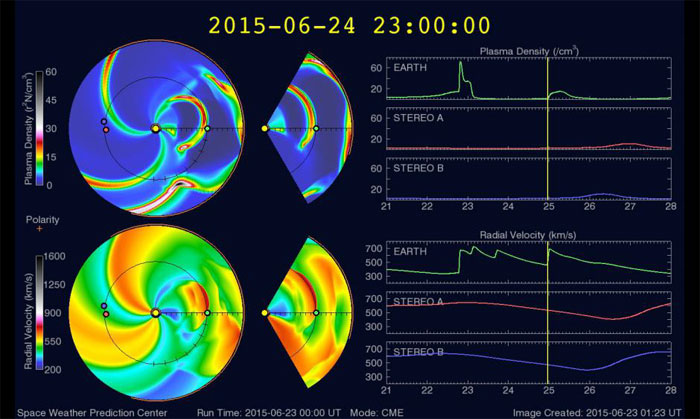
ANOTHER STORM FORECAST FOR WEDNESDAY NIGHT/THURSDAY
published: Tuesday, June 23, 2015 03:27 UTC
The coronal mass ejection that erupted June 22 in conjunction with the R2 solar flare has been modeled and arrival is expected June 24 at 2300 UT (7 pm EDT). This timing bodes well for aurora watchers in North America. As for the expected intensity, SWPC is continuing to analyze the event and will update the forecast when this analysis is complete. Stay tuned here for updates.
.
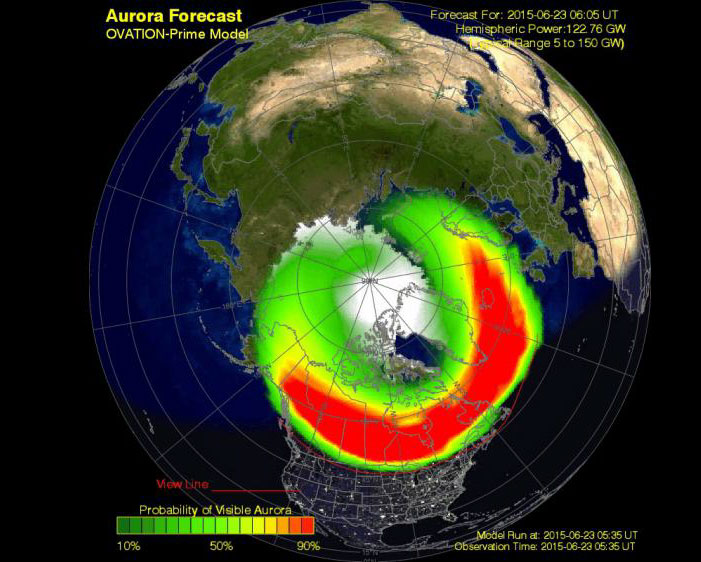
GEOMAGNETIC STORMING REACHES G4 (SEVERE) LEVELS
published: Tuesday, June 23, 2015 06:13 UTC
The geomagnetic storm that began on 22 June has reached G4 (Severe) levels once again as of 0513 UTC (0113 EDT) on 23 June.
Solar wind conditions remain highly favorable for continued Strong Geomagnetic storming, with both fast solar wind and strong magnetic fields. Aurora watchers in North America, especially northern tier states of the US, should stay alert.
Quelle: NOAA
4648 Views
